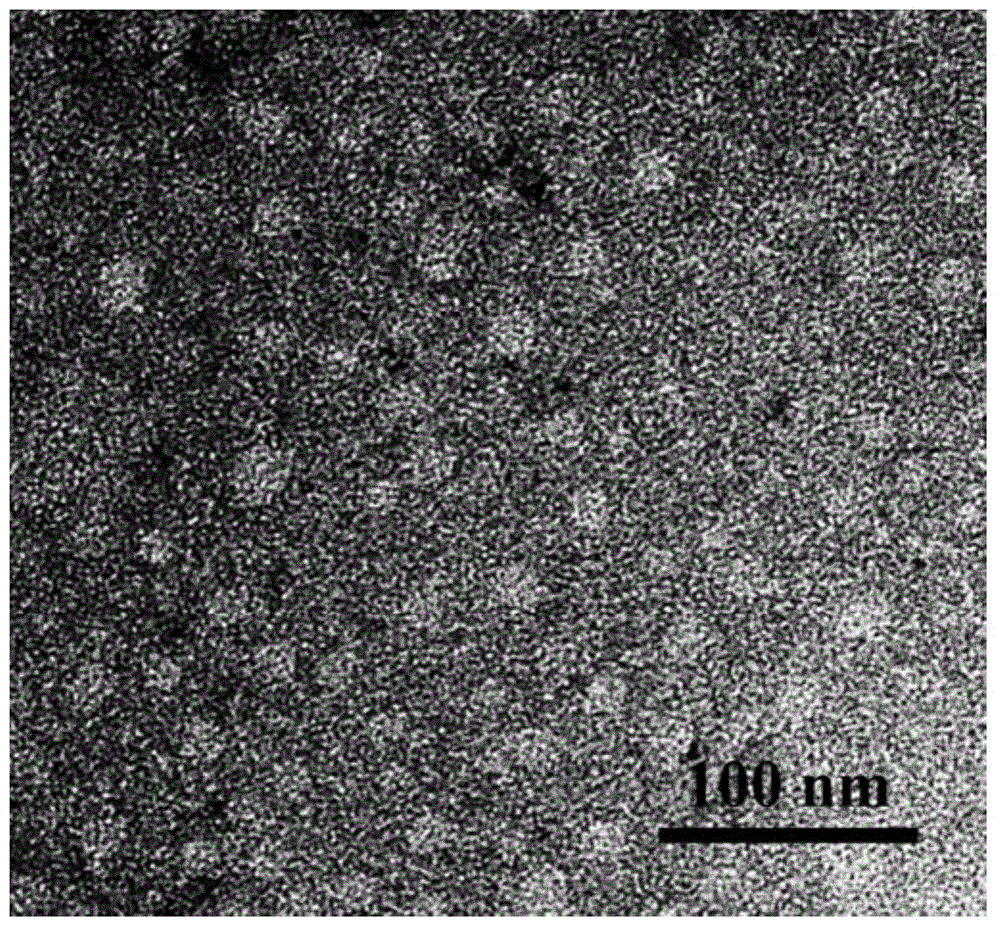Preparation method of polysaccharide-based nanometer particles sensitive to tumor microenvironments
A tumor microenvironment and nanoparticle technology, which is applied in the field of environment-sensitive nanoparticle preparation, can solve the problems of tumor cell killing, poor tumor selectivity, tissue damage, etc., and achieve broad application prospects, efficient and convenient synthesis, and uniform particle size Effect
- Summary
- Abstract
- Description
- Claims
- Application Information
AI Technical Summary
Problems solved by technology
Method used
Image
Examples
Embodiment 1
[0029] Dissolve 0.25 g of dextran (molecular weight of 40,000 Da) in 25 ml of water, stir until fully dissolved, pass nitrogen to deoxidize for 1 hour, add dilute nitric acid solution containing 0.06 g of cerium ammonium nitrate under nitrogen protection and uniform stirring, and make the reaction The final pH of the system is between 1-2. After about 5 minutes, 0.06 ml of acrylic acid monomer was added, and half an hour later, 0.012 g of diallyl disulfide crosslinking agent (dissolved in 0.2 ml of dimethyl sulfoxide solution) was added, and the reaction was carried out at 30°C for 5 hours. After the reaction, transfer to a dialysis bag with a molecular weight cut-off of 14,000Da, and dialyze in pure water for one week to ensure the removal of impurities such as unreacted monomers in the reaction system, that is, to obtain dextran-based tumor-reducing environment-sensitive nanoparticles. Aqueous solution of particles. Nanoparticles were obtained after freeze-drying.
[0030]...
Embodiment 2
[0032] Dissolve 0.6 g of temperature-sensitive hydroxypropyl cellulose (molecular weight: 80,000 Da) in 50 ml of water, stir until fully dissolved, and pass argon for 1 hour to remove oxygen in the system, under argon protection and uniform stirring Add 0.04 g of dilute nitric acid solution of ammonium cerium nitrate to make the final pH of the reaction system between 1-2. After about 10 minutes, 0.05 ml of methyl acrylate was added, and after 30 minutes, 0.040 g of bisacrylcystamine cross-linking agent (dissolved in an appropriate amount of aqueous solution) was added, and the reaction was carried out at 30° C. for 4 hours. After the reaction, transfer to a dialysis bag with a molecular weight cut-off of 14,000Da, and dialyze in pure water for a week to ensure the removal of impurities such as unreacted monomers in the reaction system, that is, to obtain a temperature-sensitive hydroxypropyl cellulose-based Tumor-reducing environment-sensitive nanoparticles in aqueous solutio...
Embodiment 3
[0034] Example 3: Dissolve 0.1 g of chitosan (molecular weight: 30,000 Da) in 50 ml of 1% (v / v) acetic acid solution, stir until fully dissolved, pass nitrogen to deoxidize for 1 hour, and add under nitrogen protection and uniform stirring 0.02 g of potassium persulfate in water. After about 5 minutes, add 0.02 g of tert-butyl acrylate, and half an hour later, add 0.003 g of bis(2-methacryloyloxyethyl) disulfide as a crosslinking agent (dissolved in 0.5 ml of dimethyl sulfoxide), React at 65°C for 4 hours. After the reaction, transfer to a dialysis bag with a molecular weight cut-off of 14,000Da, and dialyze in pure water for one week to ensure the removal of impurities such as unreacted monomers in the reaction system, that is, to obtain a stable aqueous solution of nanoparticles based on chitosan. Nanoparticles were obtained after freeze-drying.
[0035] The nanoparticles obtained in this system are regular in shape by transmission electron microscopy, basically spherical,...
PUM
| Property | Measurement | Unit |
|---|---|---|
| particle diameter | aaaaa | aaaaa |
| hydrodynamic diameter | aaaaa | aaaaa |
| diameter | aaaaa | aaaaa |
Abstract
Description
Claims
Application Information
 Login to View More
Login to View More - R&D
- Intellectual Property
- Life Sciences
- Materials
- Tech Scout
- Unparalleled Data Quality
- Higher Quality Content
- 60% Fewer Hallucinations
Browse by: Latest US Patents, China's latest patents, Technical Efficacy Thesaurus, Application Domain, Technology Topic, Popular Technical Reports.
© 2025 PatSnap. All rights reserved.Legal|Privacy policy|Modern Slavery Act Transparency Statement|Sitemap|About US| Contact US: help@patsnap.com

